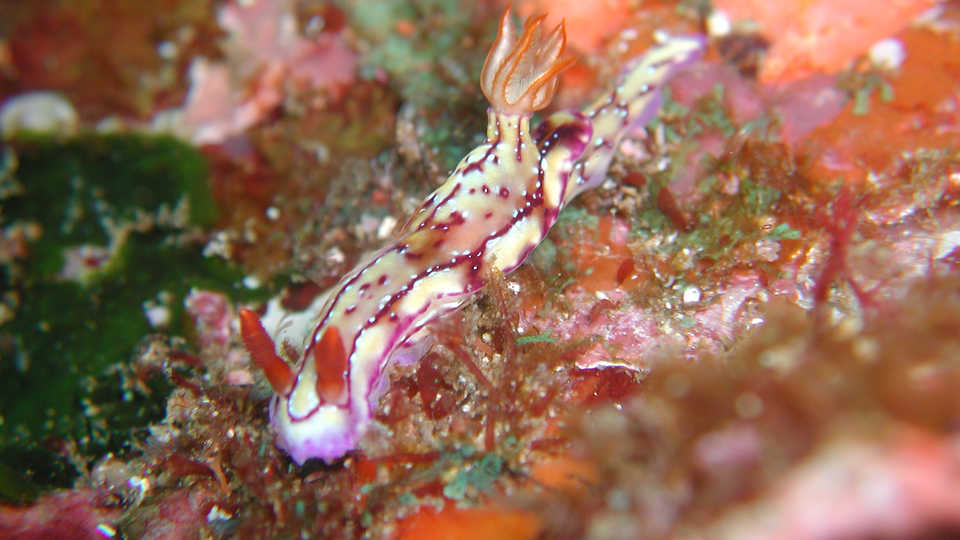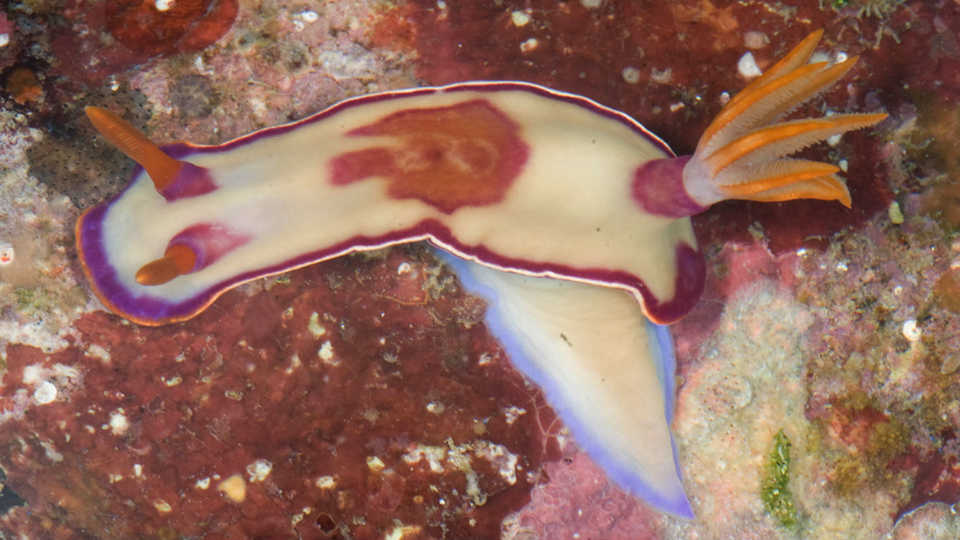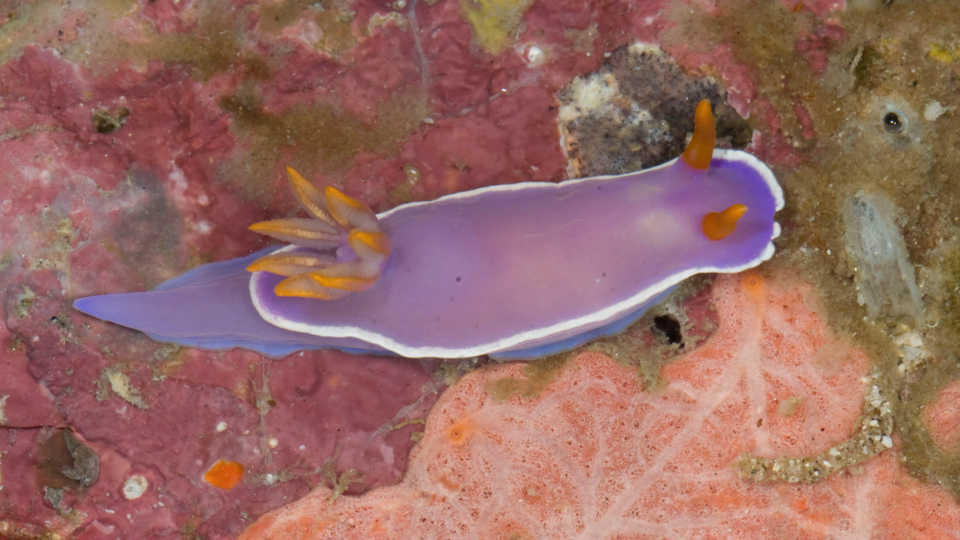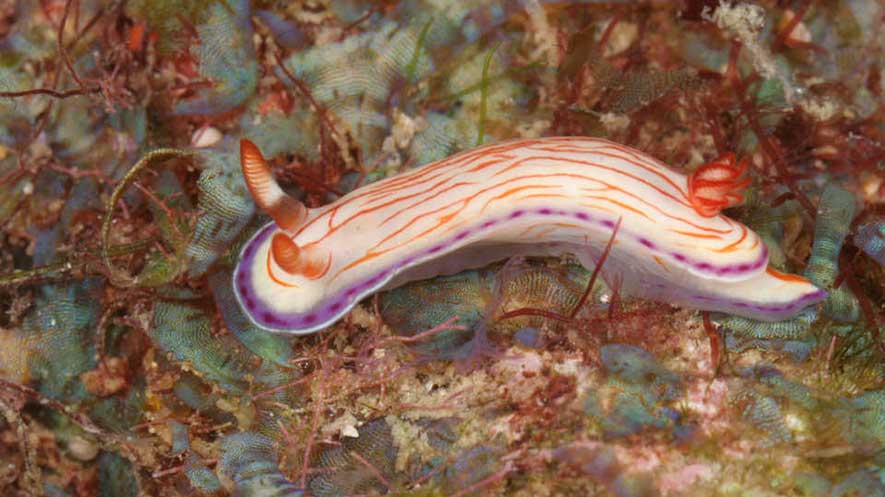This National Sea Slug Day (October 29), scientists celebrated the addition of 17 new species of nudibranch to the tree of life. Adorned in lavish patterns and colors that range from yellow polka dots to shades of mauve and neon blue, the new marine invertebrates hail from coral reefs across the Indo-Pacific region.
Researchers from the California Academy of Sciences described the new-to-science sea slugs in the Zoological Journal of the Linnean Society last month. The team also identified a number of distant relatives that have independently evolved the same color pattern -- a first-ever genetic confirmation that color mimicry is widespread in the sea slug world. Their findings reveal how much more there is to learn about what drives nature's styling of these flashy reef residents.
 Hypselodoris cerisae (© Rie Nakano)
Hypselodoris cerisae (© Rie Nakano)
"Nudibranchs have always been a marine marvel with their dazzling color diversity," says Academy curator Dr. Terry Gosliner, an invertebrate zoologist who's discovered over one-third of all sea slug species known to exist. "We're only beginning to understand the evolution of color. This is the first time we've had a family tree to test longstanding hypotheses for how patterns evolve."
The team examined the well-photographed genus Hypselodoris, a group of sea slugs that encompasses all 17 of these new finds. Two decades ago, Gosliner and Academy scientist Dr. Rebecca Johnson considered species relationships within the group on the basis of anatomy, not color. Now equipped with cutting-edge genetic tools, the team reorganized the family tree for Hypseledoris taking both color and anatomy into account. In the process, they revealed how color patterns arise among -- and even within -- species.
 Hypselodoris iba is a new species of sea slug that occurs in both white and purple. (Terry Gosliner © California Academy of Sciences)
Hypselodoris iba is a new species of sea slug that occurs in both white and purple. (Terry Gosliner © California Academy of Sciences)
"When we find an anomaly in color pattern, we know there's a reason for it," says lead author Hannah Epstein, former Academy volunteer and researcher at James Cook University in Australia. "It reveals a point in evolution where a selective pressure -- like predation -- favored a pattern for camouflage or mimicking another species that may be poisonous to would-be predators."
One such color anomaly was revealed in Hypseledoris i ba, a species that crawls across Indonesian reefs in two strikingly different color patterns: one lavender with a white stripe, and one cream with a lavender stripe and orange spots. The two were thought to be different species until a diver took a photograph of them mating. The lavender version of Hypseledoris iba looked strikingly similar to another purple species common to the region, Hypselodoris bullocki. Genetic data later proved that the different-colored individuals represented the same species.
"When two different species like H. iba and H. bullocki present in the same color, the simplest explanation is that they share a common ancestor," says Johnson. "These two species, however, are pretty far apart on the family tree: the more likely explanation for their similar appearance is that they reside in the same geographic region where being purple is advantageous for avoiding predators either as camouflage or warning of distastefulness."
The team assembled a number of "color trees" within the Hypselodoris group to better understand how evolution determines sea slugs' flashy wardrobes. They confirmed through genetic analysis several instances of species from distantly related groups evolving similar color patterns, a phenomenon known as convergent evolution.
"Sea slugs have an arsenal of strategies for surviving, from mimicry to camouflage to cryptic patterns," says Gosliner, who's described over 1,000 nudibranch species and mentored a new generation of sea slug scientists. National Sea Slug Day coincides with Gosliner's birthday, in part to celebrate his legendary career. "We're always thrilled to discover new sea slug diversity. Because nudibranchs have such specialized and varied diets, an area with many different species indicates a variety of prey -- which means that coral reef ecosystem is likely thriving."
 Hypselodoris iba is a new species of sea slug that occurs in both white and purple. (Terry Gosliner © California Academy of Sciences)
Hypselodoris iba is a new species of sea slug that occurs in both white and purple. (Terry Gosliner © California Academy of Sciences)
Nudibranchs are important indicators of declining ocean conditions, too. In 2015, a population explosion of the Hopkins' Rose nudibranch along the California coast signaled a serious shift in ocean climate and warming seas.
"Nudibranchs are more than just colorful ambassadors for the coral reef systems they inhabit," says Johnson. "Documenting their diversity and monitoring their regional presence helps us understanding how ecosystems are faring."
Johnson, who now co-leads the Academy's Citizen Science Program, reminds that one of the 17 newly described species was named after a curious citizen scientist that aided in its discovery by taking a photo (only to learn later they had documented a new species). On National Sea Slug Day (#seaslugday) and every day, nature enthusiasts along the coast can celebrate sea slug diversity by exploring local tidepools and uploading images of their finds using the free mobile app iNaturalist.
Source: California Academy of Sciences



